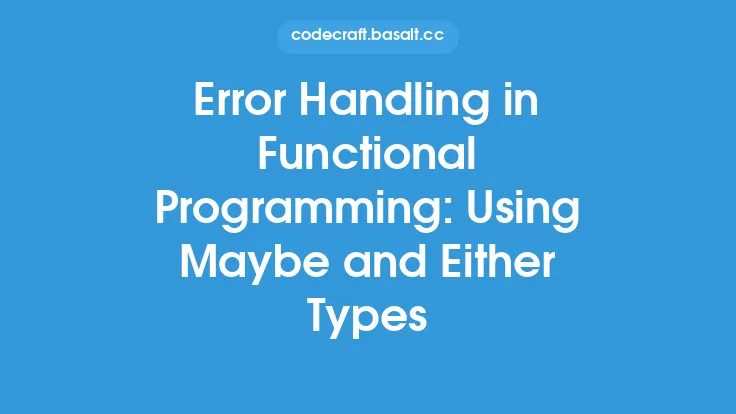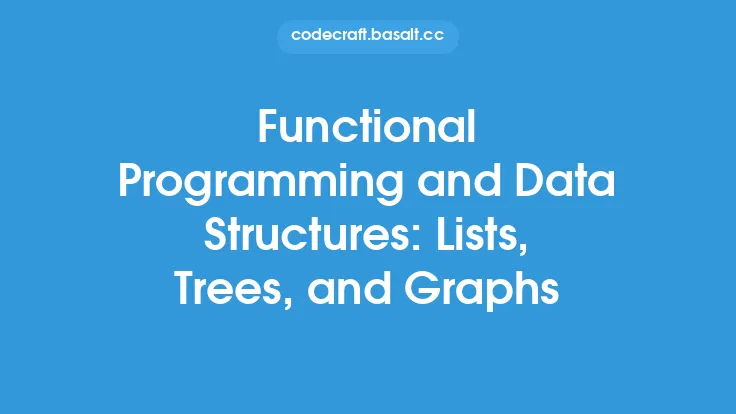Functional programming is a paradigm that emphasizes the use of pure functions, immutability, and the avoidance of changing state. One crucial aspect of functional programming that ensures the correctness and safety of code is the type system. A type system is a set of rules that govern the types of data that can be used in a program, and it plays a vital role in preventing type-related errors at runtime.
Introduction to Type Systems
A type system is a way to classify data into different categories, called types, based on their structure and behavior. Each type defines a set of values and operations that can be performed on those values. The primary goal of a type system is to ensure that the data used in a program is valid and consistent, which helps to prevent type-related errors and makes the code more maintainable and efficient. In functional programming, type systems are particularly important because they help to ensure the correctness of functions and their compositions.
Static vs Dynamic Type Systems
There are two main types of type systems: static and dynamic. A static type system checks the types of variables at compile time, before the code is executed. This means that type errors are caught early in the development process, and the code is less likely to have type-related errors at runtime. On the other hand, a dynamic type system checks the types of variables at runtime, which means that type errors may only be discovered when the code is executed. Functional programming languages such as Haskell and Scala have static type systems, while languages like JavaScript and Python have dynamic type systems.
Type Inference
Type inference is the process of automatically determining the types of variables in a program. This is particularly useful in functional programming, where the types of variables are often complex and difficult to determine manually. Type inference algorithms can analyze the code and determine the types of variables based on their usage and the types of other variables. This helps to reduce the amount of type annotations required in the code, making it more concise and easier to read. For example, in Haskell, the type inference algorithm can automatically determine the types of variables based on their usage, which means that developers do not need to explicitly specify the types of variables in most cases.
Type Classes
Type classes are a way to define a set of functions or operations that can be performed on a type. They are similar to interfaces in object-oriented programming, but are more flexible and powerful. Type classes are used to define a set of functions or operations that can be performed on a type, and they can be used to overload functions and operators. For example, in Haskell, the `Num` type class defines a set of functions and operations that can be performed on numeric types, such as addition and multiplication. Type classes are a fundamental concept in functional programming, and are used extensively in languages such as Haskell and Scala.
Algebraic Data Types
Algebraic data types (ADTs) are a way to define complex data types using a combination of sum and product types. Sum types are used to define a type that can be one of several alternatives, while product types are used to define a type that is a combination of several components. ADTs are particularly useful in functional programming, where they can be used to define complex data structures such as trees and graphs. For example, in Haskell, the `Maybe` type is an ADT that can be either `Just a` or `Nothing`, where `a` is a type variable. ADTs are a fundamental concept in functional programming, and are used extensively in languages such as Haskell and Scala.
GADTs
Generalized algebraic data types (GADTs) are an extension of ADTs that allow for more complex and expressive data types. GADTs are used to define data types that are parameterized by types, and they can be used to define complex data structures such as dependent types. GADTs are particularly useful in functional programming, where they can be used to define complex data structures such as indexed types and dependent types. For example, in Haskell, the `Vec` type is a GADT that represents a vector of a given length, where the length is a type parameter. GADTs are a powerful concept in functional programming, and are used extensively in languages such as Haskell and Idris.
Dependent Types
Dependent types are a type system feature that allows for the definition of types that depend on the value of a term. This means that the type of a term can depend on the value of another term, which allows for more expressive and flexible type systems. Dependent types are particularly useful in functional programming, where they can be used to define complex data structures such as indexed types and GADTs. For example, in Idris, the `Vec` type is a dependent type that represents a vector of a given length, where the length is a value that is known at compile time. Dependent types are a powerful concept in functional programming, and are used extensively in languages such as Idris and Agda.
Conclusion
In conclusion, type systems play a crucial role in ensuring the correctness and safety of functional programming code. Static type systems, type inference, type classes, algebraic data types, GADTs, and dependent types are all important concepts in functional programming that help to prevent type-related errors and make the code more maintainable and efficient. By understanding these concepts, developers can write more robust and reliable functional programming code, and take advantage of the many benefits that functional programming has to offer.





